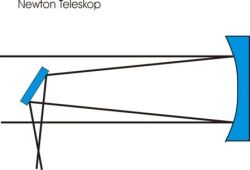The Newtonian reflector
|
The Newtonian reflector is the classic mirror telescope design. The principle is straightforward yet ingenious. Isaac Newton first built this telescope in 1668. Actually, Newton was further developing an existing telescope design, as the physicist Zucchi had already constructed a telescope in 1616 which employed a mirror. Newton's idea was to install a flat deflecting mirror into the telescope tube. Just imagine: A telescope that was originally designed in 1668 is still one of the most popular and best-selling amateur telescope designs today, in the age of smart phones and iPads! How a Newtonian telescope works:Light first enters the top of the telescope tube. At the lower end there is a primary mirror that is either spherical or parabolic in configuration. This mirror reflects the light back upwards. In order to prevent the image to be focused in front of the tube opening (and hence obscured by your head!), there is a secondary mirror inside the top of the tube. This is a plane mirror which deflects the light beam by 90°, hence directing it out the side of the tube. The light enters the focuser here, into an eyepiece can then be inserted for observing. Focusing takes place by turning a focus wheel on the focuser so that the eyepiece is moved towards or away from the telescope tube. The advantagesAs opposed to a lens telescope, a reflector has no lenses. This means that the problem of colour fringing around bright objects is avoided with Newtonian reflectors. But that is not the only criterion for producing a good image. Equally important are the quality and reflectance of the mirrors - which can be very different, depending on the telescope. It is hence important to rely on well-known brands.
Newtonian reflectors come in a relatively wide range of aperture ratios. Whereas refractors tend to have smaller aperture ratios (e.g. f/10, to reduce chromatic aberration), Newtonian telescopes can confidently be designed with optics of up to f/4. This means that Newtonian telescopes are optically ‘fast’ and have relative short focal lengths. A major advantage with Newtonian telescopes is their affordable price. As compared to refractors and other telescope designs, such as Schmidt-Cassegrains, a Newtonian telescope is simply unbeatable in price. For relatively little money, you get optical performance for which you would have to pay significantly more for most other telescope designs. The disadvantagesOne disadvantage of Newtonian telescopes, as compared with refractors, is the shadow produced on the incident light by the secondary mirror. Depending on the size of the secondary mirror, a lesser amount of light gets to the eye than originally enters the telescope tube. This is also known as ‘obstruction’. In comparison, a refractor has no components in the light beam’s path and thus has no obstruction. This means that a refractor of a given aperture will always provide more light and more contrast than a reflector of the same size. A brief example of obstruction is shown here:
Newtonian telescopes with a catadioptric designThere are also Newtonian telescopes that do not conform to the ‘classic’ design, but have an additional lens or corrector plate. These instruments are called catadioptric Newtonian telescopes. Schmidt-Newtonian telescopes have a Schmidt corrector plate mounted in front of the telescope. This plate provides a closed system which also means that there is always the same air in the tube, which ensures that it does not quickly change in temperature. Another advantage is that this plate corrects aberrations arising from the primary mirror. The secondary mirror is mounted behind the Schmidt plate, and so its spider vane mounting does not interfere. But there are other catadioptric Newtonian telescope designs that do not have a Schmidt plate. They occur mainly in the lower price range and have a Barlow lens (or a similar lens) incorporated into the light beam’s path to increase the focal length. This allows the overall telescope tube length to remain short and the focal length can be made as long as possible.
Example of a catadioptric Newton telescope
|
 |
